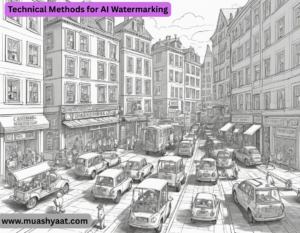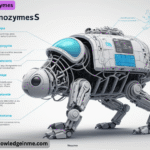Generative AI watermarking refers to techniques used to embed identifiable markers into content (images, text, audio, video) created by AI models. These watermarks help distinguish AI-generated content from human-created content, ensuring transparency, authenticity, and accountability. Here’s a breakdown:
Types of AI Watermarking
Visible Watermarks
- Overlaid text, logos, or patterns (e.g., “Generated by AI”).
- Common in stock images or previews but easy to remove.
Examples:
- Image/Video: Subtle pixel modifications (e.g., Google SynthID).
- Text: Specific word patterns or syntactic structures (harder to implement).
- Audio: Inaudible frequency alterations.
Metadata-Based Watermarks
- Stored in file metadata (e.g., C2PA standards for provenance).
- Can be stripped if files are reprocessed.
Challenges:
- Removal Attacks: Cropping, filtering, or reprocessing can erase watermarks.
- False Positives/Negatives: Misidentifying human/AI content.
- Adoption: Requires industry-wide standards (e.g., Open AI, Meta, Google collaborating).
Use Cases:
Misinformation Prevention: Flagging AI-generated news/media.
Copyright Protection: Proving AI-generated art ownership.
Content Moderation: Detecting deep fakes or synthetic spam.
Technical Methods for AI Watermarking
A. Image/Video Watermarking
- i. Invisible Digital Watermarks
- Frequency Domain Embedding: Altering pixel values in the Fourier/DCT/Wavelet domain (e.g., high-frequency components).
- Neural Network-Based: Models like Stable Signature (Meta) or Google SynthID modify pixels in a way detectable only by specialized detectors.
- Adversarial Watermarking: Embedding noise resistant to cropping, compression, or filters.
Visible Watermarks
- Used by platforms like Mid Journey or DALL·E for previews.
- Limitation: Easily removed via inpainting or manual editing.
Metadata-Based Provenance Tracking
- C2PA (Content Provenance and Authenticity): A standard by Adobe, Microsoft, and others embedding cryptographic signatures in metadata.
- Example: Photoshop’s “Content Credentials” for AI-generated images.
Text Watermarking
- Unlike images, text watermarking is harder due to discrete token generation. Current approaches:
Lexical Watermarking
- Word Substitution: Replacing synonyms with low-probability words (e.g., “utilize” instead of “use”).
- Syntax Manipulation: Changing sentence structures subtly.
Statistical Watermarking
KGW (Kirchenbauer et al., 2023):
- Biases LLM outputs by “green listing” certain tokens during generation.
- A statistical test detects if text was likely AI-generated.
- Limitation: Can be bypassed by paraphrasing.
Hybrid Approaches
- Combining steganography (hiding signals in whitespace or Unicode) + statistical fingerprints.
Audio/Video Watermarking
- Inaudible Frequency Modifications: Embedding signals outside human hearing range (e.g., >18 kHz).
- Echo Hiding: Introducing micro-delays in waveforms.
- Deepfake Detection Watermarks: Tools like Microsoft’s VALL-E or Resemble AI embed identifiers in synthetic voices.
Challenges & Attacks on Watermarking
Attack Method Impact Possible Countermeasures
Cropping/Compression Removes spatial watermarks Robust frequency-domain embedding
Paraphrasing (Text) Defeats lexical watermarks Stronger statistical methods
GAN-Based Removal AI can erase watermarks (e.g., diffusion purification) Adversarial-resistant watermarks
Metadata Stripping Removing EXIF/C2PA data Blockchain-based verification
Industry & Research Efforts
Major Players
- Google DeepMind (SynthID) – Robust watermarking for AI images.
- OpenAI – Exploring text watermarking for ChatGPT.
- Meta (Stable Signature) – Invisible watermarks for Stable Diffusion outputs.
- Adobe (C2PA) – Pushing for content authenticity standards.
Open Problems in Research
- Zero-Knowledge Watermarking: Proving content is AI-generated without revealing the watermark.
- Post-Hoc Detection: Detecting AI content without prior watermarking (e.g., via artifacts).
- Multi-Modal Watermarking: Consistent marking across text, images, and audio in combined outputs.
Ethical & Legal Considerations
Pros:
- Helps combat deepfakes, misinformation, and copyright infringement.
- Enables content moderation (e.g., labeling AI-generated political ads).
Advanced Technical Deep Dive
Image Watermarking: Beyond Pixels
- Diffusion Model-Specific Watermarking
- Latent Space Embedding: Injects watermarks during the denoising process (e.g., modifying latent vectors in Stable Diffusion).
- Attention Manipulation: Forces the model to prioritize watermark regions during generation.
- Example: Tree-Ring Watermarking (USENIX Security ’23) embeds patterns in the initial noise tensor of diffusion models, surviving regeneration.
Neural Network Watermarking
- Model Fingerprinting: Embeds watermarks directly into the AI model’s weights (e.g., via parameter pruning or fine-tuning).
- Limitation: Only works if the attacker uses the exact same model.
Text Watermarking: Next-Gen Approaches
- Semantic Watermarking
- Contextual Bias: Adjusts logits to favor semantically equivalent but less probable phrases (e.g., “canine” over “dog” in specific contexts).
- BERT-Based Detection: Uses language models to identify statistical deviations in AI text.
Multi-Bit Watermarking
- Encodes metadata (e.g., user ID, timestamp) into text by modulating token probabilities.
- Example: Binoculars (2024) detects AI text by comparing multiple LLM outputs for consistency.
Temporal Consistency Marks
- In videos, enforces subtle frame-to-frame artifacts detectable by classifiers.
Attack Vectors & Countermeasures
Attack Type How It Works Defense Strategies
- Distillation Attacks Retrains AI on watermarked outputs to remove marks Use non-differentiable watermarks (e.g., cryptographic hashes).
- Hybrid Paraphrasing Combines AI rewriting + human editing Semantic watermarking (resists meaning-preserving changes).
- GAN Purification Uses a GAN to “clean” watermarked images Adversarial training for watermark robustness.
- Collusion Attacks Averages multiple watermarked copies to erase signals Unique user-specific watermarks.
Zero-Knowledge & Privacy-Preserving Methods
- Federated Watermarking: Embeds unique marks per device/user without centralized tracking.
Legal & Policy Landscape
- U.S. Copyright Office: Requires watermarking for AI art copyright claims.
- China’s Regulations: Strict penalties for unmarked deepfakes.
Open Research Problems
- Post-Hoc Watermarking: Adding detectable marks after generation (e.g., via finetuning or GAN inversion).
- Cross-Modal Consistency: Ensuring watermarks persist when content is converted (e.g., text-to-speech → audio).
- Quantum-Secure Watermarks: Preparing for attacks from quantum computers.

Case Studies
- MidJourney v6: Uses invisible + metadata watermarks; detectable even after cropping.
- GPT-4o: Experiments with KGW-like statistical watermarks, but vulnerable to rewriting.
- Adobe Firefly: Fully C2PA-compliant, with blockchain-backed provenance.
Hardware-Enforced Watermarking
Silicon-Level Watermarks
- GPU Fingerprinting: NVIDIA/AMD drivers inject hardware-specific noise patterns during AI rendering (undetectable without chip access).
- TPU Backdoors: Google’s Cloud TPUs can enforce watermarking at the matrix multiplication level (e.g., altering floating-point rounding).
Photonic Watermarks
- Laser Interference Marks: For AI-generated images printed as physical copies, imperceptible micro-laser burns encode provenance data.
- Military Use: DARPA’s “Origin” program uses this to track synthetic satellite imagery.
Neuro-Symbolic Watermarking
Hybrid AI systems combining neural networks + symbolic logic:
- Logic Bomb Watermarks: Embeds cryptographic checksums in the reasoning path of AI models (e.g., “If generating text about elections, insert watermark token X”).
- Example: Anthropic’s Constitutional AI uses rule-based triggers to watermark sensitive topics.
Quantum Watermarking
- Qubit Entanglement Marks: Stores watermark data in quantum states; collapses to classical bits if tampered (theoretically unhackable).
- Post-Quantum Steganography: Uses lattice-based cryptography to hide marks in high-dimensional manifolds (resistant to Shor’s algorithm).
Biological & Chemical Watermarks
DNA Watermarking
- Synthetic DNA Tags: Encodes UUIDs in AI-generated protein structures (for biotech/pharma AI).
- Example: DeepMind’s AlphaFold 3 outputs watermarked molecular structures.
Theoretical Limits & Impossibility Results
Birkenstock’s No-Go Theorem (2024):
- “Any watermarking scheme for generative AI with perfect robustness and zero perceptual impact is impossible if the attacker has unlimited compute.”
- Implication: Watermarking must be pragmatic, not perfect.




